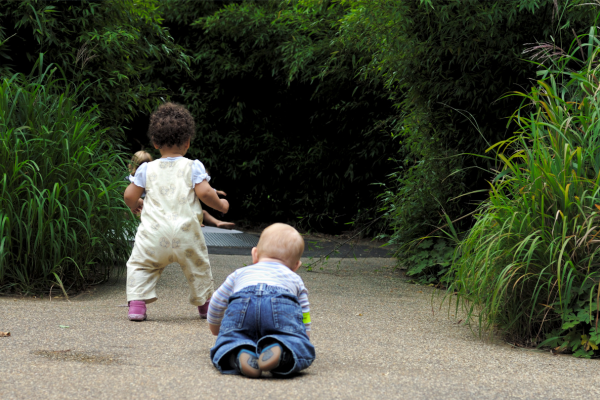
Retained Primitive Reflexes: 7 Signs Your Child Might Still Have Them
Primitive reflexes are automatic movements in infants that serve as building blocks for later voluntary motor control and developmental milestones. These reflexes are essential for our newborns’ survival, helping with functions like feeding, gripping, and rooting. However many of the primitive reflexes typically integrate or “fade” between six months and one year of life as the brain matures. When these reflexes are retained beyond infancy, they can interfere with physical, emotional, and cognitive development, creating a range of challenges.
In this post, we'll explore what retained primitive reflexes are, the implications of their persistence, and the benefits of primitive reflex therapy and reflex integration therapy.
Keep reading to learn the following about retained Primitive Reflexes:
What the 8 primitive reflexes are
Signs & symptoms of retained primitive reflexes
6 benefits of primitive reflex integration therapies
Signs adults may have retained primitive reflexes
Understanding the 8 Primitive Reflexes and Their Functions
Primitive reflexes play crucial roles in the earliest stages of physical, cognitive, social and emotional development. The eight reflexes are movements that help infants adapt to and engage with the world, setting important foundations:
Moro Reflex: Also known as the startle reflex, is a response to sudden changes in sensory input, such as a loud noise or sudden movement, causing the infant to extend their arms and legs and then retract them.
Rooting Reflex: This reflex helps the infant locate food by turning their head toward any touch on their cheek.
Palmar Grasp Reflex: Stimulated by pressure on the infant’s palm, this reflex causes them to grip an object firmly, like your finger.
Asymmetrical Tonic Neck Reflex (ATNR): This reflex occurs when a baby reaches one arm out to their side, and subsequently turns their gaze and body position to do so.
Spinal Galant Reflex: This reflex is connected to flexibility in our spine and hips allows us to be able to move in various ways, to include crawling and walking.
Symmetrical Tonic Neck Reflex (STNR): This reflex connects the head movements with the rest of the body to help bring the body into positions to crawl, sit, and stand.
Landau Reflex: When babies are held with their bellies facing the earth or even on their tummy, they typically arch their back with arms and legs outstretched, like Superman allowing their head to look up.
Tonic Labyrinthine Reflex (TLR): This reflex helps infants with head movement and muscle tone, leading to postural stability.
These primitive reflexes serve as foundational movements that lay the groundwork for motor, sensory, and neurological development. However, if any of these reflexes are retained beyond the typical timeframe, they can indicate delayed development or neurological concerns.

7 Signs and Symptoms of Retained Primitive Reflexes
There are many signs and symptoms of retained primitive reflexes. Common indicators of retained primitive reflexes include:
Difficulty sitting still or excessive fidgeting
Poor balance and coordination
Challenges with fine motor skills, like handwriting
Emotional awareness (dysregulation) or heightened anxiety
Sensory sensitivities, particularly to sound, touch, or movement
Delays in speech or language skills
Impaired focus or concentration
Let's explore what the it looks like when the different primitive reflexes are retained, and how you can gain support.
What the Primitive Reflexes Look Like When They are Retained
Retained primitive reflexes are those that persist beyond the age when they are typically integrated. When a reflex remains active, it can impact a child’s development in various ways. Let's take a look at how each might present:
Moro Reflex: If retained, this reflex can contribute to hypersensitivity, heightened anxiety, emotional awareness or 'regulation' challenges, exaggerated startle response and find it difficult to filter sensory input, leading to sensory overload.
Rooting Reflex: When retained, it can impact speech and articulation. Children may also develop poor eating habits and display tactile defensiveness around their face and mouth.
Palmar Grasp Reflex: If not integrated, this reflex can interfere with fine motor skills, including handwriting and proper pencil grip, as well as inhibit finger independence necessary for tasks requiring manual dexterity.
Asymmetrical Tonic Neck Reflex (ATNR): Retention of this reflex can affect balance, reading, coordination, and visual motor tracking.
Spinal Galant Reflex: When retained, is can affect potty training, digestion, balance, coordination, and neurodiversity challenges.
Symmetrical Tonic Neck Reflex (STNR): If not integrated, this reflex can lead to poor core strength affecting muscle tone, balance, and coordination.
Landau Reflex: When not integrated, this reflex affects muscle tone and ability to coordinate the upper and lower body, and delayed motor development.
Tonic Labyrinthine Reflex (TLR): If retained, this reflex can interfere with balance, spatial awareness, ability to climb, motion sickness, and head position.
These retained reflexes can have far-reaching effects on a child's development and behavior, affecting areas like focus, learning, emotional resilience, and even social interactions. In some cases, retained reflexes are also linked to ADHD, sensory processing disorder (SPD), dyslexia, and dyspraxia. But there is hope! With the support of primitive reflex therapy and the Heart Centred Parenting course, you can empower your child with integration tools.
What is Primitive Reflex Integration and Reflex Integration Therapy?
Primitive reflex therapy is a targeted approach designed to address retained primitive reflexes. Primitive reflex integration therapy involves a series of movements and exercises that replicate infant reflex patterns, encouraging the nervous system to integrate or "turn off" the reflexes. This form of therapy often includes:
Reflex-Specific Exercises: These exercises mimic the developmental movements patterns associated with each primitive reflex, helping to stimulate the brain and gradually integrate the reflex providing children with foundational movements they may have missed or struggled with early on.
Sensory and Motor Integration Activities: Activities designed to engage multiple sensory systems simultaneously, such as auditory, visual, and tactile, can help children achieve better sensory processing and coordination.
Consistent Repetition and Practice: Therapy typically requires regular sessions and practice at home. It’s essential for caregivers to work with their child on these exercises consistently to see progress.
Primitive Reflex Therapy as Part of a Holistic Approach: When integrated into a holistic approach, primitive reflex therapy can be even more effective. Some tools you may consider incorporating include; mindfulness and breathing techniques, nutritional support, sensory rich activities like nature play, art and music, regular physical activity and rest.
With consistent practice and holistic support, children and adults can experience significant improvements in their motor, sensory, and emotional capabilities, leading to enhanced quality of life and greater ease in day-to-day functioning.

6 Benefits of Primitive Reflex Integration
Therapies aimed at reflex integration can offer transformative benefits for children and adults with retained primitive reflexes, including:
Improved Coordination and Motor Skills: By integrating reflexes, children may experience improvements in fine and gross motor skills, making activities like sports, handwriting, and self-care tasks more manageable.
Enhanced Focus and Attention: Retained reflexes can interfere with focus and concentration. As these reflexes are integrated, children often experience greater ease in focusing on tasks and sustaining attention.
Reduced Sensory Sensitivities: Reflex integration helps the nervous system process sensory input more effectively, which can alleviate sensitivities to sound, touch, or movement.
Emotional Regulation: Integrating primitive reflexes can result in a calmer nervous system. Children with better-integrated reflexes may find it easier to manage their emotions, leading to reduced anxiety and enhanced self-regulation.
Better Academic Performance: As focus, coordination, and fine motor skills improve, many children see positive changes in their academic performance, particularly in reading, writing, and math.
Enhanced Social Interactions: When sensory and emotional challenges are minimized, children are often more comfortable in social settings, fostering better relationships with peers and family members.
Can Adults Have Retained Primitive Reflexes?
Though primitive reflexes are most commonly addressed in children, adults can also have retained reflexes, particularly if they experienced early developmental disruptions, trauma, or neurological conditions. Adults with retained reflexes may notice symptoms such as chronic tension, poor posture, anxiety, or difficulties with organization and time management. Reflex integration therapy is also available for adults and can be beneficial for enhancing physical coordination, stress resilience, and cognitive performance.
Finding Reflex Integration Therapy Support
If you suspect that retained primitive reflexes might be affecting your child or yourself, seeking support from a specialist in reflex integration therapy or getting a referral through your paediatrician can be highly beneficial. Occupational therapists, physical therapists, and other neurodevelopmental specialists often have training in reflex integration techniques. They can assess for retained reflexes and create a personalized plan with exercises and movement activities tailored to the individual’s needs.
You are also welcome to reach out to me if you have questions. I am a Craniosacral Practitioner for infants to adults, trained as a BrainDance™ Instructor, have a Yoga Alliance Registered Children's Yoga School, and strong understanding of the body, fascia, and reflexes. All of this work I have combined to create Holistic Developmental Integration Therapy ©, an intuitive and practical approach to empower families.
Want to Learn More?
Read "Understanding the 8 Senses & Sensory Processing Disorder"
Have a child under 1? Learn how to integrate HDIT© in the first year here
If you're a parent, explore Holistic Developmental Integration Therapy © here
If you have any questions, please feel free to reach out!
🌺 Katie
Please note that this information is intended for educational purposes only and should not be considered medical advice. Always consult with a healthcare professional for personalized guidance.
